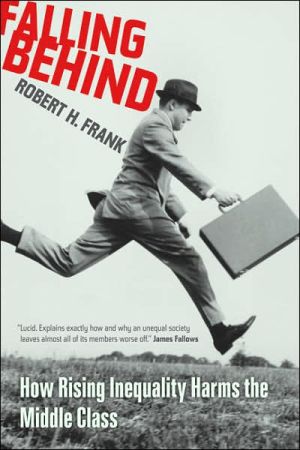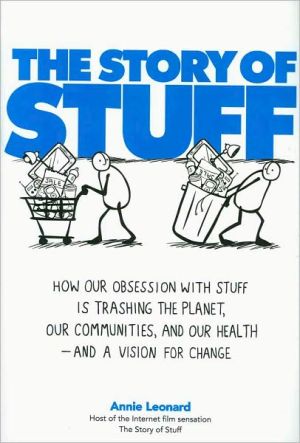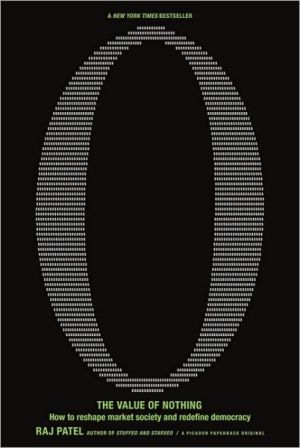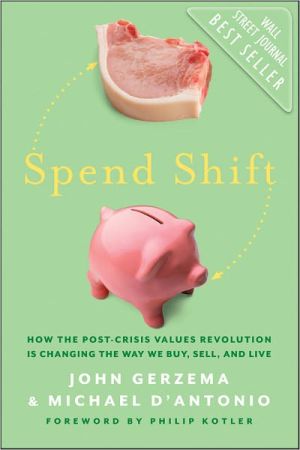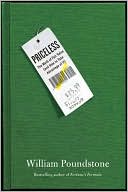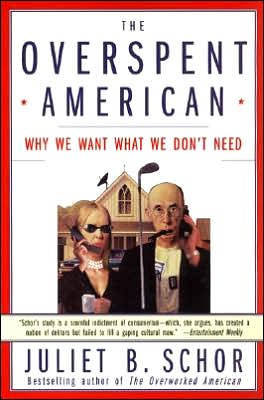Falling Behind: How Rising Inequality Harms the Middle Class
Although middle-income families don't earn much more than they did several decades ago, they are buying bigger cars, houses, and appliances. To pay for them, they spend more than they earn and carry record levels of debt. In a book exploring the very meaning of happiness and prosperity in America today, Robert Frank explains how increased concentrations of income and wealth at the top of the economic pyramid have set off "expenditure cascades" that raise the cost of achieving many basic goals...
Search in google:
"I've been a skeptic. Bob Frank is persistent. He's beginning to convince me."—Thomas C. Schelling, author of The Strategy of Conflict"The arguments here are powerful and multidisciplinary. The crux is explaining how rising economic inequality causes harm to the middle class. It also offers a policy reform—a progressive consumption tax—that serves to mitigate this harm. This is a gem of a book."—Lee S. Friedman, Professor of Public Policy, University of California at Berkeley"In this lively provocative book filled with memorable new examples, Bob Frank goes beyond his previous work (Luxury Fever, Winner-Take-All Society, and Choosing the Right Pond) and clarifies that 'falling behind' is a consequence not of envy but rather of the simple fact that a person's evaluation of his own possessions 'depends always and everywhere on context'—an unconscious comparison with his neighbor's possessions or with his own previous possessions. His illuminating interchange with prominent discussants is a unique contribution of this book."—Laurence Seidman, Chaplin Tyler Professor of Economics, University of Delaware"You may think that you understand what's in Bob Frank's earlier books, Choosing the Right Pond and Luxury Fever. You may even have read them. Nevertheless, if you pay even passing attention to the big economic policy questions, you should still read his latest contribution, Falling Behind. In this century, distributional concerns will top the policy agenda. This masterful essay will change how you think about them."—Paul Romer, Stanford University"The most influential ideas often turn out to be those that seem obvious—once someone has had the wit to point them out. Robert Frank's ideas in Falling Behind meet this test. In this short, lucid set of essays he explains exactly how and why an unequal society leaves almost all its members worse-off, including most of those who objectively are doing 'better.' This is a very important application of economic logic to modern America's main domestic problem."—James Fallows, National Correspondent, The Atlantic Monthly"Robert Frank escapes the fog of economics wars by illuminating the meaning of facts on the ground, not numerical theories in the sky. He sketches a theory of human economic nature and links it responsibly to the rickety choices of policy-makers who have no such theory or, worse, a truly faulty one."—Lionel Tiger, Rutgers University"Robert Frank is the rare sort of economist whose work disconcerts economists and delights the rest of us. This is not mainly because he mischievously highlights the blind spots of his learned profession, but because his insights reveal fundamental, unnoticed, and yet very important truths about the society in which we live. As inequality has grown in America over the last three decades, Frank shows in this fluent and powerful little book, we have all been led by human nature to act in ways that are bad for virtually everyone. Frank's ideas should play an important and innovative role in the gathering debate about inequality in America."—Robert D. Putnam, Harvard University The New York Times - Daniel Gross In his new book Falling Behind: How Rising Inequality Harms the Middle Class, Professor Frank deftly updates the argument for our current gilded age. The rise of an overclass, he convincingly argues, is indirectly affecting the quality of life of the rest of the population—and not in a good way.
Falling Behind\ How Rising Inequality Harms the Middle Class \ \ By Robert H. Frank \ UNIVERSITY OF CALIFORNIA PRESS\ Copyright © 2007 The Regents of the University of California\ All right reserved.\ ISBN: 978-0-520-25252-3 \ \ \ \ Chapter One\ Introduction \ Many years ago, I attended a lecture by a philosopher who began his talk with a thought experiment. For me as a listener, that approach worked so well that in the years since I have tried to employ it myself at every opportunity. A recent conversation with a neuroscientist friend shed some light on why this device is often so effective. Different parts of the brain, it seems, specialize in thinking about different things. When we are confronted with a question in a specific domain, blood flows to the relevant part of the brain, priming it to think more effectively about the related ideas to follow.\ So I want to begin by asking you to conduct not one but two thought experiments. Each is addressed to that part of your brain that thinks - and, more important, that cares, in the most deeply personal way - about inequality. Try as best you can to imagine that you are actually confronting the hypothetical choices I am about to describe.\ In each case, you must choose between two worlds that are identical in every respect except one. The first choice is betweenWorld A, in which you will live in a 4,000-square-foot house and others will live in 6,000-square-foot houses; and World B, in which you will live in a 3,000-square-foot house and others in 2,000-square-foot houses. Once you choose, your position on the local housing scale will persist.\ According to the standard neoclassical economic model of choice, which holds that utility depends on the absolute amount of consumption, the uniquely correct choice is World A. For if absolute house size is all that matters, A is indeed a better world for all, since everyone has a larger house there than the largest house in World B. The important thing, though, is to focus on how you would feel in the two worlds.\ In fact, most people say they would pick B, where their absolute house size is smaller but their relative house size is larger. Even those who say they would pick A seem to recognize why someone might be more satisfied with a 3,000-square-foot house in B than with a substantially larger house in A. If that is true for you as well, then you accept the main premise required for the arguments I will present.\ In the second thought experiment, your choice is between World C, in which you would have four weeks a year of vacation time and others would have six weeks; and World D, in which you would have two weeks of vacation and others one week. This time most people pick C, choosing greater absolute vacation time at the expense of lower relative vacation time.\ I use the term positional good to denote goods for which the link between context and evaluation is strongest and the term nonpositional good to denote those for which this link is weakest. In terms of the two thought experiments, housing is thus a positional good, vacation time a nonpositional good. The point is not that absolute house size and relative vacation time are of no concern. Rather, it is that positional concerns weigh more heavily in the first domain than in the second.\ The argument I will advance in this book can be reduced to four simple propositions.\ 1. People care about relative consumption more in some domains than in others. Or, to put this proposition in more neutral language, context matters more in some domains than in others. The two thought experiments just discussed illustrate this proposition. Although context matters for evaluations of both housing and leisure time, it matters more for evaluations of housing. 2. Concerns about relative consumption lead to "positional arms races," or expenditure arms races focused on positional goods. In the context of the two thought experiments, this proposition says that individuals will work longer hours to earn the money that will enable them to buy larger houses, expecting to enjoy the additional satisfaction inherent in owning a relatively large house. 3. Positional arms races divert resources from nonpositional goods, causing large welfare losses. When people contemplate working longer hours to buy larger houses, they anticipate additional satisfaction not only from having a larger house in absolute terms, but also from having a larger house in relative terms. For the move to appear attractive, the anticipated sum of these two gains must outweigh the loss in satisfaction associated with having fewer hours of leisure. When all make the same move in tandem, however, the distribution of relative house size remains essentially as before. So no one experiences the anticipated increase in relative house size. When the dust settles, people discover that the gain in absolute house size alone was insufficient to compensate for the leisure that had to be sacrificed to get it. Yet failure to buy a larger house when others do is not an attractive option for the individual, either. As in the familiar stadium metaphor, all stand to get a better view, but when all stand no one sees better than when all were seated.\ Because proposition 3 contradicts standard assertions about efficient resource allocation in competitive markets, the impulse of many economists will be to reject it. Yet its logic is precisely the same as the logic that governs the analogous, and completely uncontroversial, claim regarding military arms races. People in every nation want both a high material standard of living and protection from aggression from other nations. To protect against aggression, resources must be diverted from other forms of consumption into military armaments. Relative expenditures clearly matter more in the armaments domain than in the consumption domain. After all, a nation that spends less than its rivals on armaments puts its political independence at risk, whereas one that spends less than its rivals on consumption risks only a reduction in relative living standards. In short, military arms races result because most people believe that being less well armed than one's rivals is more costly than having fewer flat-panel television sets. By the same token, positional arms races result because consumption evaluations are more sensitive to context in some domains than in others. 4. For middle-class families, the losses from positional arms races have been made worse by rising inequality. As I will presently discuss, most of the income gains in the United States during the past several decades have gone to people at the top of the income distribution. Not surprisingly, their higher incomes have led these people to build larger houses. There is little evidence that middle-class families envy the good fortune of the wealthy. Yet through a chain of indirect effects I will describe, the larger houses at the top have led families in the middle to spend sharply higher fractions of their incomes on housing, in the process forcing them to curtail other important categories of spending.\ Our task in the pages ahead will be to examine these propositions in greater detail. But before taking up the question of whether rising inequality harms the middle class, I will first examine the extent to which inequalities in income and wealth have, in fact, been rising.\ Chapter Two\ Recent Changes in Income and Wealth Inequality \ Presidential aspirants since Ronald Reagan have urged us to ask whether we're better off now than we were four years ago. At any time from 1945 to the early 1970s, the answer for most Americans would have been a resounding yes. Throughout that period, incomes grew at about 3 percent a year for families up and down the income ladder.\ Today, however, this question is more difficult to answer. During the past several decades, the distributions of income and wealth in the United States have changed in such a way that the economic environment for most upper-middle-class people has become much more like that of World A than of World B in our earlier thought experiment. For example, although the top 1 percent of earners now have more than three times as much purchasing power as in 1979, the real earnings of families in the middle have risen only slightly since then. The meager income growth that these families have experienced has come not from hourly wage increases, but rather from growth in the labor force participation of married women.\ The conventional wisdom has long been that a growing gap between the rich and the middle class is a bad thing. But that view is now under challenge. Some revisionists, respected economists among them, argue that inequality doesn't really matter so long as no one ends up with less in absolute terms. Using income levels to measure the well-being of individual families, these inequality optimists argue that since the rich now have much more money than before and the middle class doesn't have less, society as a whole must be better off.\ Yet "having more income" and "being better off" do not have exactly the same meaning. I will argue that changes in spending patterns prompted by recent changes in the distributions of income and wealth have imposed not only important psychological costs on middle-income families but also a variety of more tangible economic costs.\ I begin with a brief look at the changes that have occurred in the distributions of income and wealth in the United States during the decades following World War II. Income growth from 1949 until the end of 1970s was well depicted by the famous picket-fence chart shown in figure 1. Incomes grew at about the same rate for all income classes during that period, a little less than 3 percent per year. It varied a bit across income classes, but no matter where you fell along the income scale, you enjoyed fairly robust income growth.\ Since consumption expenditures tend to track incomes closely, spending was also increasing at a fairly uniform rate across the income scale during this period. The houses in which rich people lived in 1979 were bigger than those of their counterparts in 1949, but the same was also true, and by roughly the same proportion, of the houses in which poor and middle-income people lived. In short, income and consumption growth were balanced across income categories during the three decades following World War II.\ That pattern began to change at some point during the 1970s. Some people date the change even earlier than that. In any event, if we look at the period from 1979 to 2003, we can see how dramatically different the later income growth pattern is from the earlier one. In the more recent period, shown in figure 2, people at the bottom of the income distribution gained only just over 3 percent in real purchasing power terms, and gains throughout the middle were also very small. For example, median family earnings were only 12.6 percent higher at the end of that twenty-four-year period than at the beginning. Income gains for families in the top quintile were substantially larger, and larger still for those in the top 5 percent. Yet even for these groups, income growth was not as great as during the earlier period. The later period was thus a time not only of slower growth but also, and more important, of much more uneven growth.\ Income inequality has also increased in two important ways not portrayed in figures 1 and 2. One is that changes in the income-tax structure during the presidency of Ronald Reagan significantly shifted real after-tax purchasing power in favor of those atop the socioeconomic ladder. Tax rates on top earners were increased slightly in the final year of the George H.W. Bush administration and further still during the administration of Bill Clinton, which also increased the earned income tax credit for working families with low incomes. But those interim adjustments were far outweighed by the large additional tax cuts targeted toward high-income families by George W. Bush. A second change not reflected in figures 1 and 2 is the magnitude of the earnings gains recorded by those at the very top.\ Figure 3 portrays some of the results of these two additional effects. Note that the middle 20 percent of earners (net of both tax and transfer payments) gained slightly more ground than in figure 2, which showed pretax incomes (net of transfer payments). Note also that the gains accruing to the top 1 percent in figure 3 are almost three times as large as the corresponding pretax gains experienced by the top 5 percent in figure 2.\ Even more spectacular income growth has occurred within the top 1 percent of earners. Only fragmentary data exist for people that high up in the income distribution, but there are snapshots here and there that show us what has been happening. One valuable source is the salaries of CEOs, which Business Week has been tracking for more than twenty years. In 1980, the CEOs of Fortune 200 companies earned about forty-two times as much as the average worker. That ratio had grown to more than five hundred times as much by 2000. And there is evidence that the gains have been even more pronounced for those who stand even higher than CEOs on the income ladder.\ (Continues...)\ \ \ \ \ Excerpted from Falling Behind by Robert H. Frank Copyright © 2007 by The Regents of the University of California. Excerpted by permission.\ All rights reserved. No part of this excerpt may be reproduced or reprinted without permission in writing from the publisher.\ Excerpts are provided by Dial-A-Book Inc. solely for the personal use of visitors to this web site. \ \
Preface viiIntroduction 1Recent Changes in Income and Wealth Inequality 6Inequality, Happiness, and Health 15Envy or Context? 29The Rising Cost of Adequate 43Why Do We Care about Rank? 52What Types of Consumption Are Most Sensitive to Context? 61How Can Middle-Class Families Afford to Keep Up? 78Smart for One, Dumb for All 87Looking Ahead 95Lessons for Public Policy 103Reflections 117Notes 127References 133Index 141
\ Daniel GrossIn his new book Falling Behind: How Rising Inequality Harms the Middle Class, Professor Frank deftly updates the argument for our current gilded age. The rise of an overclass, he convincingly argues, is indirectly affecting the quality of life of the rest of the population—and not in a good way.\ —The New York Times\ \
